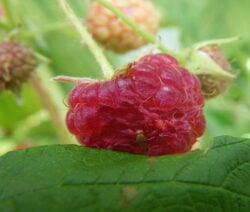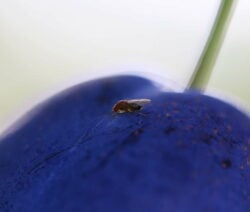Cherry Vinegar Fly: Recognizing, Preventing And Controlling
The cherry vinegar fly can not only attack wine. Here you can find out how to recognize the small fruit flies and how to prevent and combat an infestation.
Symptoms: How to recognize an infestation of the cherry vinegar fly
Table of Contents
The cherry vinegar fly attacks all types of soft fruit, including grapes, cherries, and blackberries. Given the choice, the fly clearly prefers raspberries and blueberries. In contrast to most of the native representatives of the vinegar fly, the cherry vinegar fly also attacks healthy fruits and is therefore a dangerous pest. Symptoms caused by the cherry vinegar fly can often only be seen when a larva has hatched from the egg that has been laid in the fruit. Once the larva has filled its stomach, the fruits fall in and become mushy. The holes in which the cherry vinegar fly lays its eggs are difficult to see with the naked eye. And who would want to eat a berry with larvae as a side dish?

The cherry vinegar fly can destroy entire harvests

The cherry vinegar fly causes massive problems in fruit growing and causes severe crop failures and even total loss

Close-up of the cherry vinegar fly
A short profile about the cherry vinegar fly:
The cherry vinegar fly (Drosophila suzukii) originally comes from Asia and was introduced to Europe in 2008. Since then, it has been spreading northwards from year to year. In southern countries like Italy, the fly is already causing massive problems in fruit growing and causing severe crop failures and even total loss.
You might so like: Rose Hip: 7 Questions And Answers About The Fruit Of The Rose Hep Bush
The great similarity to the native fruit flies makes identification almost impossible for the hobby gardener.

The sexes differ mainly in size

Cherry vinegar flies can lay innumerable eggs

The cherry vinegar fly causes severe crop failures and even total loss
With a size of only 2 – 3 mm, it can still cover several kilometers. In relation to the size of the little fly, that’s an extremely long distance. However, their long-range flight skills are not quite sufficient, which is why the most common form of distribution is still the export of infected fruit.
You might so like: Coral Plant (Solanum Pseudocapsicum): Care And Properties
One warm season is enough for one cherry vinegar to fly to develop into 15 new generations. Its main weak point is its sensitivity to cold temperatures. The flies already die at slight temperatures below zero. However, they also survive the winter in ventilation slots and other hiding places in heated buildings.
Cherry vinegar fly: preventive measures
Since nobody wants to eat wasted fruit, preventive measures are crucial. As the end-user, we have little influence on the further spread of the cherry vinegar fly. With a few tricks, the cherry vinegar fly can still be kept away from the berries in your own garden. The most complex and at the same time most effective method is to net the fruit trees and bushes. Since the flies almost exclusively attack ripe fruits, the net must be attached while the fruits are still green. The whole thing only works with a mesh size of at most 0.8 mm.
Another method is to build a trap. To do this, simply take a transparent PET bottle and rinse it well. Then poke around ten 3 – 4 mm holes in the upper area. You can use a metal needle, for example, which is best heated over a tea light. Then the bottle is filled with attractants. Vinegar and red wine are particularly suitable for this. A splash of washing up liquid should not be missing, otherwise, the flies will not go under and may leave the trap again. The bottle is now hung up at the height of the fruit and will probably fill up quickly with fruit flies (because the local fruit flies cannot resist this scent either). The success of this trapping method increases with the number of traps.

An effective method to stand up to the flies
If you already have infected plants, then all infected fruits must be destroyed. The fruits must not simply be put on the compost, because from there the flies can spread again. To be on the safe side, you should put the infected fruit in a plastic bag that is as transparent as possible and place it in the blazing sun for several days. The heat kills the larvae and the fruits can then be put on the compost.
Fight cherry vinegar fly
Direct control of the cherry vinegar fly after the fruit has been attacked is not possible. The reason for this is that the fruit is attacked when it is ripe and spraying shortly before the fruit is consumed would be irresponsible. The active ingredients of the spray do not have enough time to be able to be broken down!






